SOON
The problem is that you could see over 1000 people dying like they did in Oregon,
Washington and in Canada when heat got high like this. But, humidity will often kill over 100 degrees in the south too.
begin quote from:
https://www.cnn.com/2021/08/31/weather/tropical-depression-ida-tuesday/index.html
https://www.cnn.com/2021/08/31/weather/tropical-depression-ida-tuesday/index.html
Ida left more than 1 million without power, possibly for weeks. And now comes the scorching heat
By Madeline Holcombe, Holly Yan and Eric Levenson, CNN
Updated 2:41 PM ET, Tue August 31, 2021
(CNN)The levees held. The power grid did not.
Millions of Gulf Coast residents who survived Ida's devastating winds and deluge of rain face a new danger -- widespread power outages that are expected to last for weeks on end, coupled with a period of excessive heat.
Ida, which made landfall Sunday as a Category 4 hurricane, has already contributed to four deaths. Hundreds of people have been rescued, but search-and-rescue crews haven't been able to access some of the hardest-hit areas, so it's not yet clear how many residents might be still be trapped by flooding or debris.
Officials say electricity might not be restored to some areas for a month, which could prove life-threatening as intense heat moves into the region.
The National Weather Service issued a heat advisory for southern Louisiana and Mississippi from 10 a.m. to 5 p.m. Tuesday. More than 2 million people in the area are under the advisory, CNN meteorologist Michael Guy said.
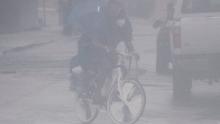
Photos: Hurricane Ida devastates Gulf Coast
A cyclist wears a face mask while biking through the rain and high winds on Canal Street in New Orleans on Sunday.
Hide Caption
29 of 57
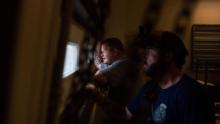
Photos: Hurricane Ida devastates Gulf Coast
Firefighters look out the window of a shelter in Bourg on Sunday as the storm passes.
Hide Caption
30 of 57
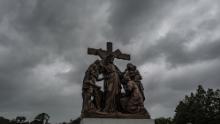
Photos: Hurricane Ida devastates Gulf Coast
Storm clouds pass over a cemetery in New Orleans on Sunday.
Hide Caption
31 of 57
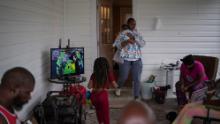
Photos: Hurricane Ida devastates Gulf Coast
LaKeisha Verdin holds her 3-month-old son, Kevin, as she walks onto the front porch where her family was watching weather updates on the local news Sunday in Houma.
Hide Caption
32 of 57
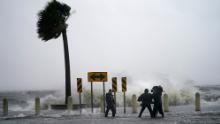
Photos: Hurricane Ida devastates Gulf Coast
A news crew reports from the edge of Lake Pontchartrain in New Orleans on Sunday.
Hide Caption
33 of 57

Photos: Hurricane Ida devastates Gulf Coast
Wind blows Monroe Best's hair and face mask Sunday in New Orleans.
Hide Caption
34 of 57
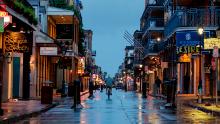
Photos: Hurricane Ida devastates Gulf Coast
Bourbon Street in New Orleans is nearly empty on Sunday.
Hide Caption
35 of 57

Photos: Hurricane Ida devastates Gulf Coast
A vehicle is abandoned in a flooded ditch next to the highway Sunday in Bay Saint Louis, Mississippi.
Hide Caption
36 of 57
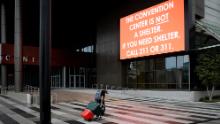
Photos: Hurricane Ida devastates Gulf Coast
A man carrying his belongings walks past a sign outside the Ernest N. Morial Convention Center in New Orleans on Sunday.
Hide Caption
37 of 57
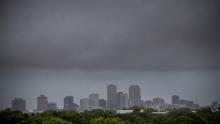
Photos: Hurricane Ida devastates Gulf Coast
A wall of rain moves over downtown New Orleans on Sunday.
Hide Caption
38 of 57

Photos: Hurricane Ida devastates Gulf Coast
The Boudreaux family sits on their front porch Sunday as they await the arrival of Hurricane Ida.
Hide Caption
39 of 57
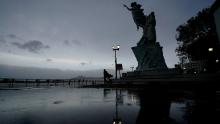
Photos: Hurricane Ida devastates Gulf Coast
A man walks along the Mississippi River near the French Quarter in New Orleans early Sunday.
Hide Caption
40 of 57
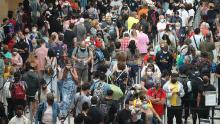
Photos: Hurricane Ida devastates Gulf Coast
People stand in line at Louis Armstrong New Orleans International Airport on Saturday, August 28. Many residents were evacuating the area ahead of Hurricane Ida.
Hide Caption
41 of 57
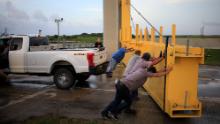
Photos: Hurricane Ida devastates Gulf Coast
Crews reopen a flood gate to help trapped motorists who missed a closure deadline on Saturday.
Hide Caption
42 of 57
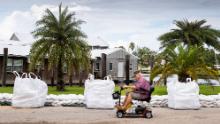
Photos: Hurricane Ida devastates Gulf Coast
Keith Clark brings a rope to a friend to help tie down a houseboat before he evacuates Jean Lafitte, Louisiana, on Saturday.
Hide Caption
43 of 57
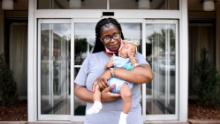
Photos: Hurricane Ida devastates Gulf Coast
Nikeia Washington from Vacherie, Louisiana, holds her granddaughter, Halia Zenon, at a hotel in downtown Shreveport, Louisiana, where they evacuated to ahead of the storm.
Hide Caption
44 of 57
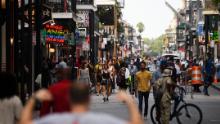
Photos: Hurricane Ida devastates Gulf Coast
People walk down Bourbon Street in New Orleans on Saturday. Evacuation was voluntary for parts of the city inside its flood protection system. Other areas were under a mandatory evacuation order.
Hide Caption
45 of 57
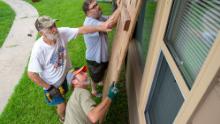
Photos: Hurricane Ida devastates Gulf Coast
Larry Ackman, bottom, helps neighbor Mike Jackson, left, and his son Cody board up windows Saturday in Morgan City, Louisiana.
Hide Caption
46 of 57
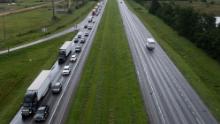
Photos: Hurricane Ida devastates Gulf Coast
Traffic moves slowly along I-10 West on Saturday in Vinton, Louisiana, as residents evacuate toward Texas.
Hide Caption
47 of 57
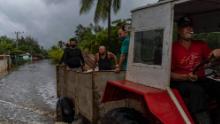
Photos: Hurricane Ida devastates Gulf Coast
A man drives a tractor through a flooded street Saturday in Guanimar, Cuba. Before entering the Gulf, Ida made landfall twice over Cuba as a Category 1 hurricane.
Hide Caption
48 of 57
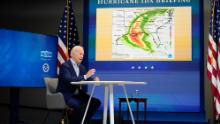
Photos: Hurricane Ida devastates Gulf Coast
President Joe Biden speaks during a FEMA briefing on Hurricane Ida on Saturday. "This weekend is the anniversary of Hurricane Katrina," Biden said, "and it's a stark reminder that we have to do everything we can to prepare the people in the region to make sure we're ready to respond."
Hide Caption
49 of 57

Photos: Hurricane Ida devastates Gulf Coast
Dawn breaks over a Hurricane Katrina memorial at Shell Beach in St. Bernard, Louisiana, on Saturday. Katrina made landfall on August 29, 2005.
Hide Caption
50 of 57
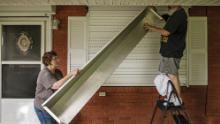
Photos: Hurricane Ida devastates Gulf Coast
Clare and Joe Cermak work on putting storm shutters up on their home in Louisiana's St. Charles Parish on Saturday.
Hide Caption
51 of 57
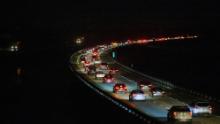
Photos: Hurricane Ida devastates Gulf Coast
Highway traffic moves slowly overnight Saturday near Kenner, Louisiana, as many residents evacuate ahead of Hurricane Ida.
Hide Caption
52 of 57
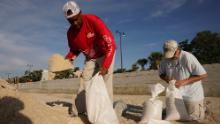
Photos: Hurricane Ida devastates Gulf Coast
Gregory Moore, left, helps fill sand bags as residents in Gulfport, Mississippi, prepare for the storm on Saturday.
Hide Caption
53 of 57
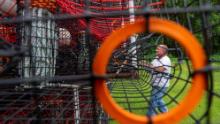
Photos: Hurricane Ida devastates Gulf Coast
John Guenther unloads about 400 crab traps that he had to pull out of the water and move via flatbed trailer to dry near his home in the eastern St. Bernard Parish on Friday, August 27.
Hide Caption
54 of 57
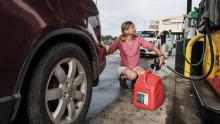
Photos: Hurricane Ida devastates Gulf Coast
Jennifer Tate fuels up a gas can Friday in Pass Christian, Mississippi.
Hide Caption
55 of 57
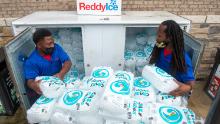
Photos: Hurricane Ida devastates Gulf Coast
Workers stack bags of ice into a gas station freezer on Friday in Jefferson, Louisiana.
Hide Caption
56 of 57
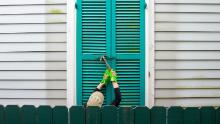
Photos: Hurricane Ida devastates Gulf Coast
A resident hammers the shutters of a 100-year-old house in New Orleans on Friday.
Hide Caption
57 of 57

Photos: Hurricane Ida devastates Gulf Coast
Michael Wilson stands in the doorway of his flood-damaged home in Norco, Louisiana, on Monday, August 30.
Hide Caption
1 of 57
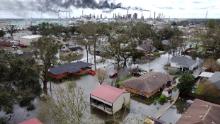
Photos: Hurricane Ida devastates Gulf Coast
Homes near Norco are surrounded by floodwaters on Monday.
Hide Caption
2 of 57
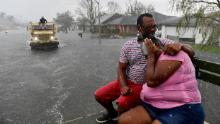
Photos: Hurricane Ida devastates Gulf Coast
A rain shower soaks evacuees in LaPlace, Louisiana, on Monday.
Hide Caption
3 of 57
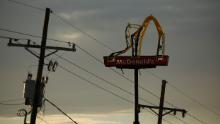
Photos: Hurricane Ida devastates Gulf Coast
A McDonald's sign is damaged in Raceland, Louisiana, on Monday.
Hide Caption
4 of 57
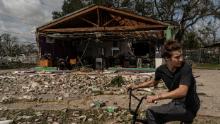
Photos: Hurricane Ida devastates Gulf Coast
A man rides a bicycle in front of a damaged building in Houma, Louisiana, on Monday.
Hide Caption
5 of 57
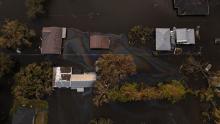
Photos: Hurricane Ida devastates Gulf Coast
An oil slick is seen on top of floodwaters in Kraemer, Louisiana, on Monday.
Hide Caption
6 of 57
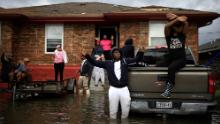
Photos: Hurricane Ida devastates Gulf Coast
Residents wave at a US Coast Guard helicopter while waiting to be rescued from their flooded home in LaPlace on Monday.
Hide Caption
7 of 57
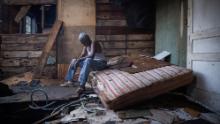
Photos: Hurricane Ida devastates Gulf Coast
Theophilus Charles, 70, sits inside his damaged home in Houma on Monday.
Hide Caption
8 of 57
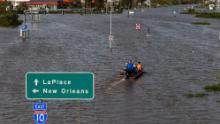
Photos: Hurricane Ida devastates Gulf Coast
The highway is flooded near LaPlace on Monday.
Hide Caption
9 of 57
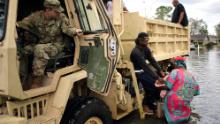
Photos: Hurricane Ida devastates Gulf Coast
Residents are rescued from floodwaters in LaPlace on Monday.
Hide Caption
10 of 57

Photos: Hurricane Ida devastates Gulf Coast
A damaged historic building lays in ruin in the Central Business District of New Orleans on Monday.
Hide Caption
11 of 57
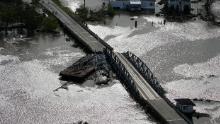
Photos: Hurricane Ida devastates Gulf Coast
A barge damages a bridge connecting Lafitte and Jean Lafitte, Louisiana, on Monday.
Hide Caption
12 of 57
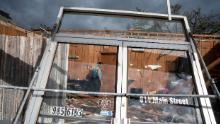
Photos: Hurricane Ida devastates Gulf Coast
Marquita Jenkins stands in the ruins of her hair salon in LaPlace on Monday.
Hide Caption
13 of 57
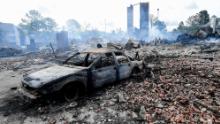
Photos: Hurricane Ida devastates Gulf Coast
A destroyed car is seen Monday after an apartment building burned overnight in Kenner, Louisiana.
Hide Caption
14 of 57
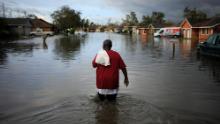
Photos: Hurricane Ida devastates Gulf Coast
A resident walks through floodwaters in LaPlace on Monday.
Hide Caption
15 of 57
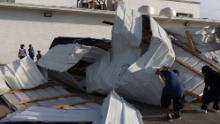
Photos: Hurricane Ida devastates Gulf Coast
Siblings watch men assess damage outside of a hotel Monday in Houma.
Hide Caption
16 of 57
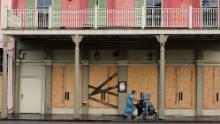
Photos: Hurricane Ida devastates Gulf Coast
A woman pushes a stroller past a boarded up building in the French Quarter of New Orleans on Monday.
Hide Caption
17 of 57
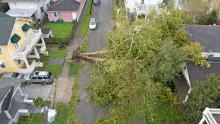
Photos: Hurricane Ida devastates Gulf Coast
A downed tree lies on a house in New Orleans on Monday.
Hide Caption
18 of 57
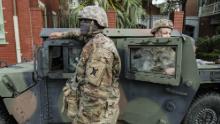
Photos: Hurricane Ida devastates Gulf Coast
Members of the Louisiana National Guard help with recovery efforts in New Orleans on Monday.
Hide Caption
19 of 57
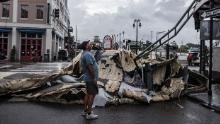
Photos: Hurricane Ida devastates Gulf Coast
A man looks up next to a section of roof that was ripped off a building in the French Quarter of New Orleans on Monday.
Hide Caption
20 of 57

Photos: Hurricane Ida devastates Gulf Coast
Lights from a TV broadcast illuminate an otherwise dark Bourbon Street in New Orleans on Monday. More than 1 million customers in Louisiana were without power Monday morning, according to PowerOutage.US -- including all of New Orleans.
Hide Caption
21 of 57

Photos: Hurricane Ida devastates Gulf Coast
Montegut Fire Chief Toby Henry walks back to his fire truck in the rain as firefighters cut through trees on the road in Bourg, Louisiana, on Sunday, August 29.
Hide Caption
22 of 57
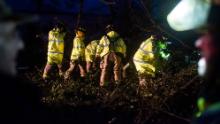
Photos: Hurricane Ida devastates Gulf Coast
Firefighters cut through downed trees on a road in Bourg on Sunday.
Hide Caption
23 of 57
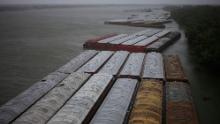
Photos: Hurricane Ida devastates Gulf Coast
Barges are seen docked on the Mississippi River as Hurricane Ida hits Destrehan, Louisiana, on Sunday.
Hide Caption
24 of 57
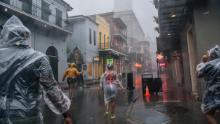
Photos: Hurricane Ida devastates Gulf Coast
People walk through the French Quarter in New Orleans on Sunday.
Hide Caption
25 of 57
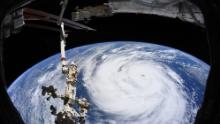
Photos: Hurricane Ida devastates Gulf Coast
European Space Agency astronaut Thomas Pesquet took this photo of Hurricane Ida on Sunday from the International Space Station.
Hide Caption
26 of 57
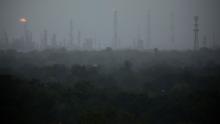
Photos: Hurricane Ida devastates Gulf Coast
The Royal Dutch Shell refinery in Norco, Louisiana, is seen as Hurricane Ida makes landfall Sunday. More than 95% of the Gulf of Mexico's oil production facilities have been shut down, regulators said, indicating the storm's significant impact on energy supply.
Hide Caption
27 of 57

Photos: Hurricane Ida devastates Gulf Coast
People work inside the Federal Emergency Management Agency's headquarters in Washington, DC, on Sunday.
Hide Caption
28 of 57

Photos: Hurricane Ida devastates Gulf Coast
A cyclist wears a face mask while biking through the rain and high winds on Canal Street in New Orleans on Sunday.
Hide Caption
29 of 57

Photos: Hurricane Ida devastates Gulf Coast
Firefighters look out the window of a shelter in Bourg on Sunday as the storm passes.
Hide Caption
30 of 57

Photos: Hurricane Ida devastates Gulf Coast
Storm clouds pass over a cemetery in New Orleans on Sunday.
Hide Caption
31 of 57

Photos: Hurricane Ida devastates Gulf Coast
LaKeisha Verdin holds her 3-month-old son, Kevin, as she walks onto the front porch where her family was watching weather updates on the local news Sunday in Houma.
Hide Caption
32 of 57

Photos: Hurricane Ida devastates Gulf Coast
A news crew reports from the edge of Lake Pontchartrain in New Orleans on Sunday.
Hide Caption
33 of 57

Photos: Hurricane Ida devastates Gulf Coast
Wind blows Monroe Best's hair and face mask Sunday in New Orleans.
Hide Caption
34 of 57

Photos: Hurricane Ida devastates Gulf Coast
Bourbon Street in New Orleans is nearly empty on Sunday.
Hide Caption
35 of 57

Photos: Hurricane Ida devastates Gulf Coast
A vehicle is abandoned in a flooded ditch next to the highway Sunday in Bay Saint Louis, Mississippi.
Hide Caption
36 of 57

Photos: Hurricane Ida devastates Gulf Coast
A man carrying his belongings walks past a sign outside the Ernest N. Morial Convention Center in New Orleans on Sunday.
Hide Caption
37 of 57

Photos: Hurricane Ida devastates Gulf Coast
A wall of rain moves over downtown New Orleans on Sunday.
Hide Caption
38 of 57

Photos: Hurricane Ida devastates Gulf Coast
The Boudreaux family sits on their front porch Sunday as they await the arrival of Hurricane Ida.
Hide Caption
39 of 57

Photos: Hurricane Ida devastates Gulf Coast
A man walks along the Mississippi River near the French Quarter in New Orleans early Sunday.
Hide Caption
40 of 57

Photos: Hurricane Ida devastates Gulf Coast
People stand in line at Louis Armstrong New Orleans International Airport on Saturday, August 28. Many residents were evacuating the area ahead of Hurricane Ida.
Hide Caption
41 of 57

Photos: Hurricane Ida devastates Gulf Coast
Crews reopen a flood gate to help trapped motorists who missed a closure deadline on Saturday.
Hide Caption
42 of 57

Photos: Hurricane Ida devastates Gulf Coast
Keith Clark brings a rope to a friend to help tie down a houseboat before he evacuates Jean Lafitte, Louisiana, on Saturday.
Hide Caption
43 of 57

Photos: Hurricane Ida devastates Gulf Coast
Nikeia Washington from Vacherie, Louisiana, holds her granddaughter, Halia Zenon, at a hotel in downtown Shreveport, Louisiana, where they evacuated to ahead of the storm.
Hide Caption
44 of 57

Photos: Hurricane Ida devastates Gulf Coast
People walk down Bourbon Street in New Orleans on Saturday. Evacuation was voluntary for parts of the city inside its flood protection system. Other areas were under a mandatory evacuation order.
Hide Caption
45 of 57

Photos: Hurricane Ida devastates Gulf Coast
Larry Ackman, bottom, helps neighbor Mike Jackson, left, and his son Cody board up windows Saturday in Morgan City, Louisiana.
Hide Caption
46 of 57

Photos: Hurricane Ida devastates Gulf Coast
Traffic moves slowly along I-10 West on Saturday in Vinton, Louisiana, as residents evacuate toward Texas.
Hide Caption
47 of 57

Photos: Hurricane Ida devastates Gulf Coast
A man drives a tractor through a flooded street Saturday in Guanimar, Cuba. Before entering the Gulf, Ida made landfall twice over Cuba as a Category 1 hurricane.
Hide Caption
48 of 57

Photos: Hurricane Ida devastates Gulf Coast
President Joe Biden speaks during a FEMA briefing on Hurricane Ida on Saturday. "This weekend is the anniversary of Hurricane Katrina," Biden said, "and it's a stark reminder that we have to do everything we can to prepare the people in the region to make sure we're ready to respond."
Hide Caption
49 of 57

Photos: Hurricane Ida devastates Gulf Coast
Dawn breaks over a Hurricane Katrina memorial at Shell Beach in St. Bernard, Louisiana, on Saturday. Katrina made landfall on August 29, 2005.
Hide Caption
50 of 57

Photos: Hurricane Ida devastates Gulf Coast
Clare and Joe Cermak work on putting storm shutters up on their home in Louisiana's St. Charles Parish on Saturday.
Hide Caption
51 of 57

Photos: Hurricane Ida devastates Gulf Coast
Highway traffic moves slowly overnight Saturday near Kenner, Louisiana, as many residents evacuate ahead of Hurricane Ida.
Hide Caption
52 of 57

Photos: Hurricane Ida devastates Gulf Coast
Gregory Moore, left, helps fill sand bags as residents in Gulfport, Mississippi, prepare for the storm on Saturday.
Hide Caption
53 of 57

Photos: Hurricane Ida devastates Gulf Coast
John Guenther unloads about 400 crab traps that he had to pull out of the water and move via flatbed trailer to dry near his home in the eastern St. Bernard Parish on Friday, August 27.
Hide Caption
54 of 57

Photos: Hurricane Ida devastates Gulf Coast
Jennifer Tate fuels up a gas can Friday in Pass Christian, Mississippi.
Hide Caption
55 of 57

Photos: Hurricane Ida devastates Gulf Coast
Workers stack bags of ice into a gas station freezer on Friday in Jefferson, Louisiana.
Hide Caption
56 of 57

Photos: Hurricane Ida devastates Gulf Coast
A resident hammers the shutters of a 100-year-old house in New Orleans on Friday.
Hide Caption
57 of 57

Photos: Hurricane Ida devastates Gulf Coast
Michael Wilson stands in the doorway of his flood-damaged home in Norco, Louisiana, on Monday, August 30.
Hide Caption
1 of 57

Photos: Hurricane Ida devastates Gulf Coast
Homes near Norco are surrounded by floodwaters on Monday.
Hide Caption
2 of 57

Photos: Hurricane Ida devastates Gulf Coast
A rain shower soaks evacuees in LaPlace, Louisiana, on Monday.
Hide Caption
3 of 57

Photos: Hurricane Ida devastates Gulf Coast
A McDonald's sign is damaged in Raceland, Louisiana, on Monday.
Hide Caption
4 of 57

Photos: Hurricane Ida devastates Gulf Coast
A man rides a bicycle in front of a damaged building in Houma, Louisiana, on Monday.
Hide Caption
5 of 57

Photos: Hurricane Ida devastates Gulf Coast
An oil slick is seen on top of floodwaters in Kraemer, Louisiana, on Monday.
Hide Caption
6 of 57

Photos: Hurricane Ida devastates Gulf Coast
Residents wave at a US Coast Guard helicopter while waiting to be rescued from their flooded home in LaPlace on Monday.
Hide Caption
7 of 57

Photos: Hurricane Ida devastates Gulf Coast
Theophilus Charles, 70, sits inside his damaged home in Houma on Monday.
Hide Caption
8 of 57

Photos: Hurricane Ida devastates Gulf Coast
The highway is flooded near LaPlace on Monday.
Hide Caption
9 of 57

Photos: Hurricane Ida devastates Gulf Coast
Residents are rescued from floodwaters in LaPlace on Monday.
Hide Caption
10 of 57

Photos: Hurricane Ida devastates Gulf Coast
A damaged historic building lays in ruin in the Central Business District of New Orleans on Monday.
Hide Caption
11 of 57

Photos: Hurricane Ida devastates Gulf Coast
A barge damages a bridge connecting Lafitte and Jean Lafitte, Louisiana, on Monday.
Hide Caption
12 of 57

Photos: Hurricane Ida devastates Gulf Coast
Marquita Jenkins stands in the ruins of her hair salon in LaPlace on Monday.
Hide Caption
13 of 57

Photos: Hurricane Ida devastates Gulf Coast
A destroyed car is seen Monday after an apartment building burned overnight in Kenner, Louisiana.
Hide Caption
14 of 57

Photos: Hurricane Ida devastates Gulf Coast
A resident walks through floodwaters in LaPlace on Monday.
Hide Caption
15 of 57

Photos: Hurricane Ida devastates Gulf Coast
Siblings watch men assess damage outside of a hotel Monday in Houma.
Hide Caption
16 of 57

Photos: Hurricane Ida devastates Gulf Coast
A woman pushes a stroller past a boarded up building in the French Quarter of New Orleans on Monday.
Hide Caption
17 of 57

Photos: Hurricane Ida devastates Gulf Coast
A downed tree lies on a house in New Orleans on Monday.
Hide Caption
18 of 57

Photos: Hurricane Ida devastates Gulf Coast
Members of the Louisiana National Guard help with recovery efforts in New Orleans on Monday.
Hide Caption
19 of 57

Photos: Hurricane Ida devastates Gulf Coast
A man looks up next to a section of roof that was ripped off a building in the French Quarter of New Orleans on Monday.
Hide Caption
20 of 57

Photos: Hurricane Ida devastates Gulf Coast
Lights from a TV broadcast illuminate an otherwise dark Bourbon Street in New Orleans on Monday. More than 1 million customers in Louisiana were without power Monday morning, according to PowerOutage.US -- including all of New Orleans.
Hide Caption
21 of 57

Photos: Hurricane Ida devastates Gulf Coast
Montegut Fire Chief Toby Henry walks back to his fire truck in the rain as firefighters cut through trees on the road in Bourg, Louisiana, on Sunday, August 29.
Hide Caption
22 of 57

Photos: Hurricane Ida devastates Gulf Coast
Firefighters cut through downed trees on a road in Bourg on Sunday.
Hide Caption
23 of 57

Photos: Hurricane Ida devastates Gulf Coast
Barges are seen docked on the Mississippi River as Hurricane Ida hits Destrehan, Louisiana, on Sunday.
Hide Caption
24 of 57

Photos: Hurricane Ida devastates Gulf Coast
People walk through the French Quarter in New Orleans on Sunday.
Hide Caption
25 of 57

Photos: Hurricane Ida devastates Gulf Coast
European Space Agency astronaut Thomas Pesquet took this photo of Hurricane Ida on Sunday from the International Space Station.
Hide Caption
26 of 57

Photos: Hurricane Ida devastates Gulf Coast
The Royal Dutch Shell refinery in Norco, Louisiana, is seen as Hurricane Ida makes landfall Sunday. More than 95% of the Gulf of Mexico's oil production facilities have been shut down, regulators said, indicating the storm's significant impact on energy supply.
Hide Caption
27 of 57

Photos: Hurricane Ida devastates Gulf Coast
People work inside the Federal Emergency Management Agency's headquarters in Washington, DC, on Sunday.
Hide Caption
28 of 57

Photos: Hurricane Ida devastates Gulf Coast
A cyclist wears a face mask while biking through the rain and high winds on Canal Street in New Orleans on Sunday.
Hide Caption
29 of 57






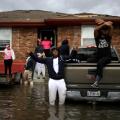

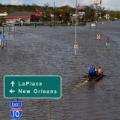
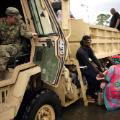



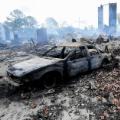
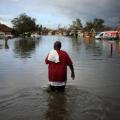
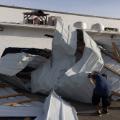
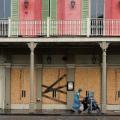
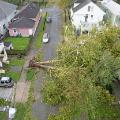

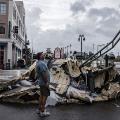



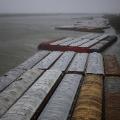
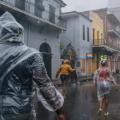
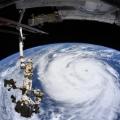
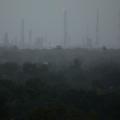

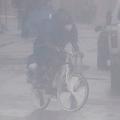


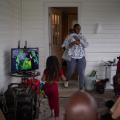
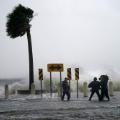

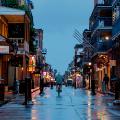
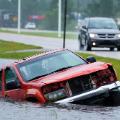
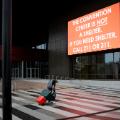
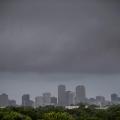

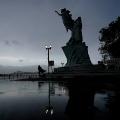
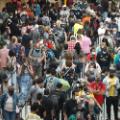
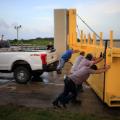
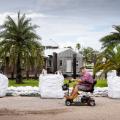

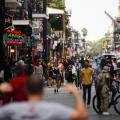
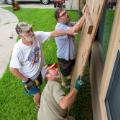
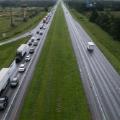
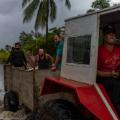
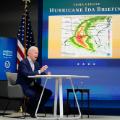

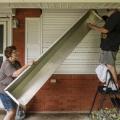

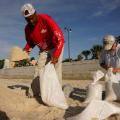




That means some residents who stayed and rode out the storm will face heat indices of up to 105 degrees -- without air conditioning. Heat is the No. 1 weather-related cause of fatalities in the US, the NWS said.
Enter your email to sign up for CNN's "Meanwhile in China" Newsletter.
close dialog
Many local officials have urged those who evacuated not to come home yet, citing downed power lines, impassable roads and potential hindrances to rescue workers.
"Many of the life supporting infrastructure elements are not present, are not operating right now," Gov. John Bel Edwards said Tuesday. "Please don't come home before they tell you that it's time."
Still, the damage left in Ida's wake is a far cry from that left by Hurricane Katrina, the 2005 storm that caused New Orleans' levee system to fail, flooding 80% of the city and killing over 1,800 people. The government has spent billions of dollars in the 16 years since rebuilding and strengthening that levee system, and the infrastructure upgrades appear to have worked as designed.
"There were a few smaller levees that were overtopped, to some degree, and for some duration of time, and that did result in some people's homes are being flooded," Edwards said Monday. "But they did not fail."
Ida remains a threat for other states across the eastern US. Now a tropical depression, the storm is bringing heavy rain and the threat of flash floods to Tennessee, the scene of deadly flooding just last week.
The system is then set to move toward the mid-Atlantic and Northeast. Nearly 80 million people are under a flash flood threat from the storm, stretching from Alabama to Massachusetts.
The center of Ida was 60 miles west-northwest of Huntsville, Alabama, or 100 miles southwest of Nashville, Tennessee, as of the 11 a.m. ET Weather Prediction Center update.
Rainfall around Ida stretches over 600 miles from Kentucky southward to the Gulf Coast. The heaviest rain is located across Kentucky and along the lines of thunderstorms stretching through Alabama and Georgia.
Weeks without electricity

The downtown skyline is shown after Hurricane Ida passed through on August 30 in New Orleans, Louisiana.
The short-term challenge for Louisiana is the failure of its power grid and its impact on gas supplies, communication networks, clean water and hospitals.
More than 1 million power customers in Louisiana, 60,000 in Mississippi, and 16,000 in Alabama are without power, according to PowerOutage.US. An electricity customer can represent an entire household or business, so the number of people who lost power is likely much higher.
The vast majority of Louisiana's outages are among customers of Entergy, which said Monday the storm damaged eight high-voltage lines serving New Orleans and other parishes. Restoring power could take more than three weeks based on historical restoration times, Entergy said.
In parts of Jefferson Parish, power is expected to be out for at least three or four weeks, Councilman at Large Ricky Templet said. Another councilman, Bryon Lee, said supplies are limited, grocery stores are closed and there is a two-hour line for gas.
And officials in St. Charles Parish it's "highly likely" the area won't have power for a month, according to a Facebook post.
More than 25,000 workers from at least 32 states and the District of Columbia have been mobilized to help restore power in Louisiana, the Edison Electric Institute said in a statement Monday.
The electricity problems have also led to gas shortages and issues at local hospitals.
Lines of cars waited for hours Monday at the one or two gas stations still open in St. Bernard Parish, Louisiana, Council Member Richard Lewis said. Many stocked up on fuel for their generators.
In addition, four hospitals in Louisiana were evacuated Monday, the governor said. In the aftermath of the hurricane, many Gulf Coast hospitals are grappling with how to keep caring for patients amid the damage.
"We really need our hospitals, more than anything else, to come back up, so that people who are in ICU rooms and on ventilators and so forth can continue to receive the life-saving care that they need," Edwards said.
"That's important all the time. It's certainly important, even more so, because of the Covid situation."
Part of a highway washed away

Volunteers Catera Whitson, center, and Kyler Melancon ride in the back of a high water truck Monday to help evacuate people from homes in LaPlace, Louisiana.
Heavy rain in Mississippi washed away part of Highway 26, a main artery between Mississippi and Louisiana, killing two people and injuring 10 others.
Seven vehicles went into a hole created by the washout, which was about about 50 feet long and 20 feet deep, Mississippi Highway Patrol Trooper Cal Robertson said.
At least two deaths in Louisiana have been linked to Ida. The first happened when a tree fell on a home in Prairieville, the Ascension Parish Sheriff's Office said Sunday. And in New Orleans, a man drowned after trying to drive through floodwater near I-10 and West End Boulevard, the Louisiana Department of Health said Monday.
In Louisiana, state police gave a blunt message to some residents Monday: "It may be difficult to get help to you for quite some time." With many roads impassable or blocked by debris, "the full extent of damage is yet to be seen," police said.
Some people closer to those in need volunteered to help. Paul Middendorf spent hours Monday rescuing people with his canoe in LaPlace, Louisiana, volunteering with the group Crowdsource Rescue.
"Most of (the rescues) were in the attic," he said. "The water in the back of that neighborhood was about 10 feet deep or higher."
Middendorf said the water slowly started to recede. Although it was only knee deep in some parts, it was still chest deep with a strong current in many areas that were still flooded in LaPlace, he said.
Those who did evacuate may not be able to return anytime soon due to unpassable roads. For those who can return, they may come back to an unrecognizable landscape.
Lafourche Parish residents, who were subject to mandatory evacuations, will be allowed to return home Tuesday at noon. However, power is out and will not be restored for some time, a nightly curfew is in place, there is no access to clean water and alcohol sales are suspended, the parish said.
"Nearly all communication is down, including cell phone service parish-wide. Your home may be severely damaged and uninhabitable," the parish said.
Correction: An earlier version of this story gave an incorrect high temperature forecast for Louisiana. The forecasted temperature will be in the upper 80s with a heat index of 105.
CNN's Keith Allen, Monica Garrett, Kay Jones, Gregory Lemos, Paul P. Murphy, Rebekah Riess, Jenn Selva and Amanda Watts and contributed to this report.




















No comments:
Post a Comment